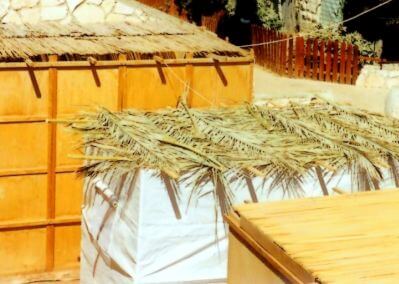Building a Sukkah
Building and living in a “Sukkah” is the observance that gives Sukkos its name, so it’s perhaps superfluous to call it one of the “highlights” of this holiday. And yet many people don’t know how to build one. It’s really kind of simple, especially if you want to go online and buy a prefabricated one – or are handy and have a Home Depot nearby. All you need are three walls – the fourth is optional – and natural vegetation, called s’chach, for the roof.
 Here’s the basics of what you need to know:
Here’s the basics of what you need to know:
1. Location, Location, Location
Your sukkah needs to be under the sky, without overhanging trees or rooftops. If your house has a small awning, even up to a few feet of overhang, you can still use the side of your house as one of the required walls, but you can’t sit under the awning-covered section. This is where you consult a rabbi when it gets complicated! Ideally, find a place under open sky.
Common pitfall: Avoid overhanging branches!
2. The Walls
The walls don’t actually need to reach all the way up to the roof of the sukkah. They need to begin near the ground – technically, three hands-breadths, which the Talmud informs us is close enough to the ground that a goat won’t be able to crawl in. So you need to ensure your sukkah is free of wandering goats.
The walls also must reach a height of 40 inches or so depending upon whom you ask. But the usual practice is to use a floor-to-ceiling wall to keep out wind and rain. In case you wondered, the walls also shouldn’t be more than 30 feet tall!
Here’s an important proviso: the walls of your sukkah shouldn’t move back-and-forth in routine wind conditions. So if the walls are canvas, for example, they need to be tied extremely tightly. Some recommend adding wood walls to encompass at least the first 40 inches, the required height.
Common pitfall: the walls must be substantial enough to not blow around in the wind.
3. The Roof
Now we get the important part, the S’chach. S’chach is natural vegetation, not including fruit. Branches and leaves are commonly used. Mats can be used under limited conditions – once considered a furnishing under Jewish law, a mat can no longer be used for s’chach. This is related to how it is built rather than how you intend to use it, so practically speaking a s’chach mat must becreated for that purpose and sold through a reputable company.
There should be enough s’chach so that your sukkah has “more shade than sun,” yet sunlight still creeps through, and the s’chach should also reach to the sides of the sukkah and cover the walls.
Common pitfall 1: Make sure there is enough s’chach that there is more shade beneath it than sunlight.
Common pitfall 2: Make sure the s’chach reaches to the sides of your sukkah.
This is, of course, a cursory guide to help you prepare. Be sure to consult a knowledgeable teacher if you have questions!
Learn About the Holiday
Sukkah Dwelling 101
Building and living in a “Sukkah” is the observance that gives Sukkos its name, so here’s your brief guide to the where and how of building one, and avoiding the common pitfalls.
Lessons from Sukkot
What lessons can be drawn from the services of Sukkos? What can we learn about the Jewish people and about humanity?
Sukkos Perspectives
A wide variety of perspectives into the depth and meaning of this monumental holiday.


